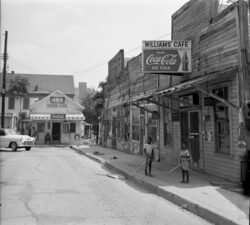St. Paul’s Bottoms
St. Paul’s Bottoms, a red-light district in Shreveport, was an experiment in controlled vice.

Northwest Louisiana Archives at LSU Shreveport
St. Paul's Bottoms became a largely African American residential neighborhood after its closure as a red-light district. Street Scene in St. Paul's Bottoms, 1957.
New Orleans’s infamous Storyville was not the first red-light district to operate in America, but it was the most influential. That influence extended to the opposite corner of Louisiana, in Shreveport, where city leaders established St. Paul’s Bottoms, a district where prostitution was “legal”—at least in a de facto sense. No other Louisiana cities followed that model, but several other American cities had such zones. Such districts were established during a time when political leaders and the public decided that law enforcement would never stamp out the vice, so they instead sought to contain it within certain geographic bounds.
Containing Vice
Between the 1830s and 1890s most of Shreveport’s vice, like its legitimate commerce, was concentrated along the Red River. Saloons accommodating gambling and prostitution were as much a part of riverfront life as cotton brokers and steamboat agents. The area between Commerce and Spring Streets, from Crockett to Fannin Streets, was the center of Shreveport’s business activity—both high and low orders. However, as the nineteenth century drew to a close, the city was evolving into a major commercial center for the region; churches had more clout in the community than they had had in antebellum days, and the city was attracting more families and fewer rowdy transients.
Still, bordellos existed on Milam Street and along the riverfront, and independent “working girls” could be found in many of the city’s hotels. In 1903 the Shreveport City Council determined that rather than try to rid the city of such enterprises, it would be more reasonable to concentrate the city’s vice into a tightly managed area, such as New Orleans had done with reasonable success a few years before. Thus was born Shreveport’s “tenderloin” area, or red-light district. Within its confines prostitution was not legalized but decriminalized—a distinction that passed muster with the courts.
The District
Roughly ten blocks in size, the irregularly shaped, low-lying St. Paul’s Bottoms took its name from the nearby St. Paul’s Methodist Church, founded in 1865. “The location did not represent the city’s best real estate, and the low-lying ‘bottoms’ were far enough removed from the river to lack the benefit of breezes in the summer,” writes historian Cheryl H. White of the district in Wicked Shreveport. “Furthermore, the land was muddy and collected water, providing a prime breeding spot for mosquitoes. However, in response to the city ordinance, prostitutes, madams, and pimps all began the process of relocating their businesses.”
St. Paul’s Bottoms was bounded by Christian Street to the west, Hunter and Fannin Streets to the south, Common Street to the east, and the Texas and Pacific Railroad tracks to the north. On higher ground nearby stood the homes of many of the city’s most prominent residents. Only two blocks east were the grand Victorian mansions of many wealthy citizens who called the lower-numbered blocks of Fannin and Caddo Streets home; the higher-numbered blocks of the same streets were occupied by both large brothels and smaller “cribs” where prostitutes lived and worked.
Growth
About forty brothels were registered within the district soon after its establishment; that number would exceed one hundred at the district’s peak. Prosperous homeowners in the district found that renting their old houses to madams made good economic sense. Prostitutes were willing to pay higher rents than itinerant workers from the riverfront, many of whom were evicted from their shotgun houses to make room for new “self-employed” tenants.
“The region primarily attracted white clientele for white prostitutes, although there were areas in the district that featured black or ‘mulatto’ girls, including the Octoroon Club on Fannin Street that advertised such girls from the New Orleans area,” writes White. New Orleans, by contrast, maintained a “black Storyville” district separate from the more prominent area that catered to a white clientele. Huddie William Ledbetter, later known as Lead Belly, spent his formative years as a young blues musician in and around the rough-and-tumble clubs of St. Paul’s Bottoms during its heyday; he commemorated his coming of age in Shreveport’s red-light district in his song “Fannin Street.”
Shutdown
In 1917 Shreveport’s population was about 40,000, and no American city of comparable size had a red-light district—legal or illegal—that large. By then the district spilled far over its legal boundaries and included more than one hundred houses of ill repute within or closely adjacent to the district’s legal limits. That year an election was held to determine the fate of St. Paul’s Bottoms. Churches and civic clubs campaigned to shut it down, while property owners and tenants put up a fight to save it. In the end moralists won by a small margin, and the fourteen-year-old experiment in controlled vice came to an end.
Most of the structures that comprised St. Paul’s Bottoms have been torn down, including all of the larger brothels. The last surviving one, located at the corner of Fannin and Douglas Streets, burned down in 1974 after having been a boarding house for many years. The forty-one buildings that remained by 1984 were listed on the National Register of Historic Places as contributing elements of Shreveport’s Allendale/Ledbetter Heights Historic District, which includes not only the former red-light district but also portions of nearby historic neighborhoods.
